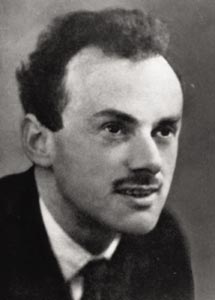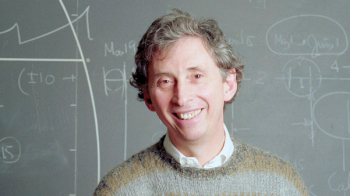This year is the 100th anniversary of Paul Adrien Maurice Dirac who was born in Bristol, England, on 8 August 1902 and died on 20 October 1984 in Tallahassee, Florida, US. Richard Dalitz looks back over a remarkable career in physics.

The year 2002 is the centennial year for Paul Dirac, who was born in Bristol on 8 August 1902. His Swiss father, Charles, was born in Monthey near Geneva in 1866 and migrated to Bristol, England, to become the French teacher at the Merchant Venturers Technical College. His mother was Florence Holten, a Cornish woman who was born in Liskeard in 1878 and became a librarian in Bristol. They married in Bristol in 1899 and had three children: two sons (of which Paul was the younger) and then a daughter. After his primary and secondary education at the technical college, Paul Dirac joined the electrical engineering department of Bristol University in 1918 to train as an electrical engineer. This choice was due to prompting from his father who was concerned about his son’s job prospects.
Dirac did well at university, but he did not find a suitable job due to post-war conditions. His desire was to go to Cambridge University to study mathematics and physics. He was accepted by St John’s College, Cambridge, in 1921, but was offered only a minor scholarship, insufficient to support him there. Fortunately, he was able to study Applied Mathematics at Bristol University for two years, paying no fees and living at home. After this, in 1923, he was awarded a major scholarship at St John’s College and a Department of Scientific and Industrial Research training grant, but even these did not cover the amount he needed to study at Cambridge. In the end he was able to go to St John’s College because extraordinary action was taken by the college. He did all his life’s work there, from postgraduate studies in 1923 to retirement from his Lucasian professorship in 1969 (excluding sabbatical leaves). Thus, it turned out that the college made a profitable investment when they gave him a modest increase to the major scholarship they had awarded him.

Paul Dirac died, aged 82, on 20 October 1984 as a Nobel Prize winner (1933) and a member of the British Order of Merit (1973). He was the outstanding theoretical physicist in Britain in the 20th century. In 1995 there was a great celebration of Dirac and his work in London. A plaque was placed in Westminster Abbey as a memorial to him and his achievements, joining similar plaques to Newton, Maxwell, Thomson, Green and other outstanding theoretical physicists. It included Dirac’s equation in a compact relativistic form (as Dirac’s full equation would not have fitted on the plaque). This was not a form that Dirac would ever have used, although later students of Dirac often used it. As part of the celebration, addresses were given on four topics related to Dirac’s work (see P Goddard 1998 in Further reading).
Monumental discoveries
Dirac established the most general theory of quantum mechanics and discovered the relativistic equation for the electron, which now bears his name. The remarkable notion of an antiparticle to each particle – i.e. the positron as antiparticle to the electron – stems from his equation. He was the first to develop quantum field theory, which underlies all theoretical work on sub-atomic or “elementary” particles today, work that is fundamental to our understanding of the forces of nature. He proposed and investigated the concept of a magnetic monopole, an object not yet known empirically, as a means of bringing even greater symmetry to Maxwell’s equations of electromagnetism. He quantized the gravitational field, and developed a general theory of quantum field theories with dynamical constraints, which forms the basis of the gauge theories and superstring theories of today. The influence and importance of his work has increased with the decades, and physicists daily use the concepts and equations that he developed.

Dirac’s first step into a new quantum theory was taken late in September 1925. R H Fowler, his research supervisor, had received a proof copy of an exploratory paper by Werner Heisenberg in the framework of the old quantum theory of Bohr and Sommerfeld, which leaned heavily on Bohr’s correspondence principle but changed the equations so that they involved directly observable quantities. Fowler sent Heisenberg’s paper on to Dirac, who was on vacation in Bristol, asking him to look into this paper carefully. Dirac’s attention was drawn to a mysterious mathematical relationship, at first sight unintelligible, that Heisenberg had reached. Several weeks later, back in Cambridge, Dirac suddenly recognized that this mathematical form had the same structure as the Poisson Brackets that occur in the classical dynamics of particle motion. From this thought he quickly developed a quantum theory that was based on non-commuting dynamical variables. This led him to a more profound and significant general formulation of quantum mechanics than was achieved by any other worker in this field (see P Dirac 1925 in Further reading).
This was a major achievement that marked him out from others in the field. As a young, 25-year-old physicist he was quickly accepted by outstanding physicists. He was invited to speak at their most exclusive conferences, such as the Solvay Congress of 1927 (see Further reading), and joined in their deliberations as an equal.

However, this general formulation allowed him to go much further. With it, he was able to develop his transformation theory, which showed explicitly (see P Dirac 1927 in Further reading) how it was possible to relate a range of different formulations of quantum mechanics, all of them equivalent in their physical consequences, such as Schrödinger’s wave equation and Heisenberg’s matrix mechanics. This was an astonishing achievement, which led to a deeper understanding of quantum mechanics and its use. This transformation theory was the pinnacle of Dirac’s development of quantum mechanics since it unified all proposed versions of quantum mechanics, as well as giving rise to a continuum of other possible versions. In later life Dirac considered this transformation theory to be his own as no other quantum mechanician had found any hint of it. Altogether, Dirac’s quantum mechanics takes a simple and beautiful form, with a structure showing elegance and economy of concept, and linked directly with the classical theory. It showed us a new aspect of our universe, both profound and perplexing in its new concepts, and certainly unexpected.
Even as an undergraduate Dirac had been deeply conscious of the importance of special relativity in physics, the theory that Einstein had put forward in 1905 and that Dirac had learned about from lectures by C D Broad, the philosophy professor at Bristol University. Most of his early papers as a postgraduate student were devoted to modifying calculations already in the literature to make them compatible with special relativity. In 1927 Dirac sought to develop a theory of the electron that satisfied this requirement and he published his relativistically invariant equation for the electron early in 1928 (see P Dirac 1928 in Further reading).
Although this goal had been in the minds of many other physicists, none had been able to find a satisfactory equation. He gave an argument, simple and of the utmost elegance, that was based on the requirement that his transformation theory should also hold for relativistic quantum mechanics – an argument that specified the general form this relativistic equation should have, an argument that all physicists have found compelling. His transformation theory requires the equation to be no more than linear in time-derivative, while relativity arguments indicate that the equation can be only linear in the space derivatives also. Dirac’s equation is certainly one of the most beautiful physics equations. Professor Sir Nevill Mott, former director of the Cavendish Laboratory, wrote recently: “This [equation] seemed, and still seems to me, the most beautiful and exciting piece of pure theoretical physics that I have seen in my lifetime – comparable with Maxwell’s deduction that the displacement current, and therefore electromagnetism, must exist.” (See B Kursunoglu and E P Wigner 1988 in Further reading.) Also, the Dirac equation for the electron implied that it should have spin 1/2, and a magnetic moment of eh/(4pm), where h is the Planck constant and m is the electron mass, correct to the accuracy of 0.1%.
Dirac’s equation and his theory of the electron have remained firm up to the present day. Its predictions have been thoroughly verified for all atomic and molecular systems. It has been demonstrated to hold for all other particles that have the same spin as the electron, such as the protons, the hyperons and all other baryons, when their induced magnetic moments are taken into account; and all known leptons, to say nothing of the fundamental building blocks of all hadrons, the quarks themselves. It is universally applicable and well known by all physicists and chemists, something nobody could deny. Indeed, in 1929 Dirac felt able to state: “The general theory of quantum mechanics is now complete… The underlying physical laws necessary for the mathematical theory of a large part of physics and the whole of chemistry are thus completely known.” (See P Dirac 1929 in Further reading.)
Beautiful physics

Dirac soon showed that his equation had other, unexpected, implications for these particles. The equation predicted the existence of antiparticles, such as the positron and the negatively charged antiproton, objects now well known in high-energy physics laboratories. Indeed, all particles have corresponding antiparticles and almost all of them are now known empirically. The positron and antiproton are particularly well known, both being stable in a vacuum, and are now widely used in collider accelerators, with which physicists study physical phenomena at very high energies.
It is important to emphasize here the outstanding beauty of Dirac’s equation. It may be difficult to convey this quality to non-scientists, but we can be confident that no physicist would disagree with this statement. The Dirac equation is one of the most outstanding discoveries. Through this work, Dirac uncovered for us all a fundamental and satisfying principle governing our universe, which demonstrates to an unsurpassed degree the elegance of its structure. For this discovery, Dirac’s name will be known forever. It is an outstanding monument to his ability and ingenuity, leading us to comprehend at least one aspect of the fundamental forces in this remarkable universe in which we live.
Dirac’s name would be high in physics records even if quantum mechanics and transformation theory were his only contributions to knowledge. His discovery of the Dirac equation puts him far above all others – an outstanding genius in the history of physics.
Further reading
P Dirac 1925 The Fundamental Equations of Quantum Mechanics Proc.R.Soc.Lond. A109 642-653.
P Dirac Electrons and Photons in 5th Conseil de Physique de l’Institut International de Physique Solvay, 24-29 October 1927, Brussels Gauthier-Villars, Paris 258-263.
P Dirac 1927 The Physical Interpretation of the Quantum Dynamics Proc.R.Soc.Lond. A113 621-641.
P Dirac 1928 The Quantum Theory of the Electron Proc.R.Soc.Lond. A117 610-624; ibid A118 351-361.
B Kursunoglu and E P Wigner (ed.) 1988 Reminiscences about a great physicist: Paul Adrien Maurice Dirac Cambridge University Press 231.
P Dirac 1929 Quantum Mechanics of Many-Electron Systems Proc.R.Soc.Lond. A123 714-733.
P Goddard (ed.) 1998 Paul Dirac: The Man and his Work Cambridge University Press. Contributors: Abraham Pais “Paul Dirac: aspects of his life and work”, Maurice Jacob “Antimatter”, David I Olive “The Monopole” and Michael F Atiyah “The Dirac equation and geometry”. The book also contains Stephen Hawking’s Dirac memorial address given at the unveiling of Dirac’s plaque at Westminster Abbey.








